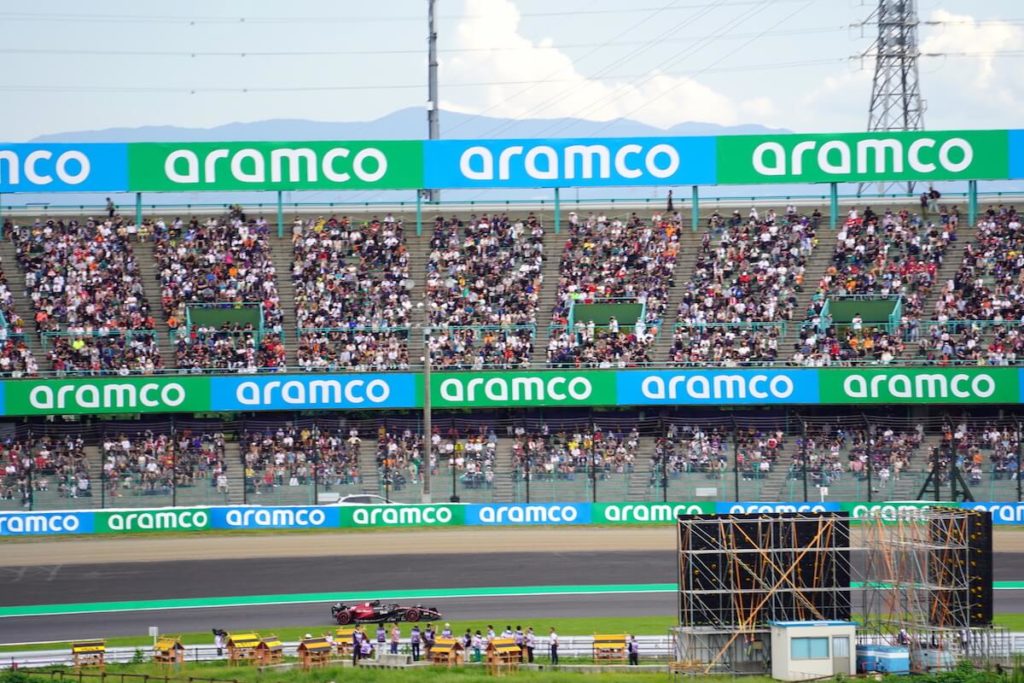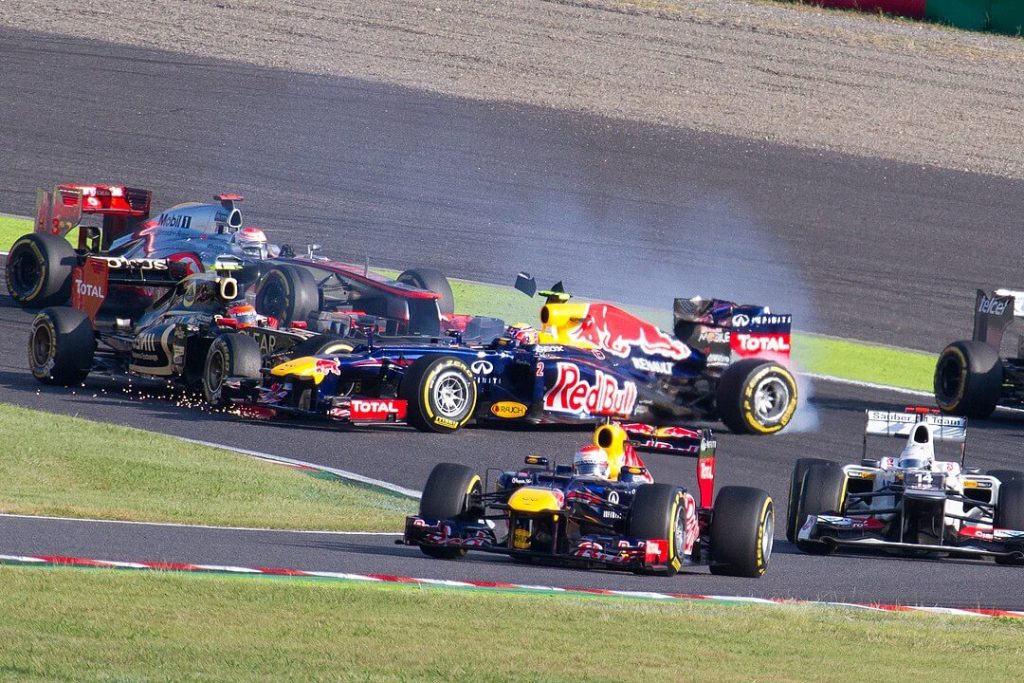

After a hunch within the 2010s, Suzuka’s attendance figures are on the rise. We have a look again over 50 years of Japanese Grand Prix to analyze the components behind altering attendance numbers on the Japanese Grand Prix.
In 1987, the primary Japanese Grand Prix at Suzuka occurred in entrance of a 247,000-strong 4-day crowd of fortunate F1 followers. Fortunate, actually, as a nation-wide lottery occurred to determine which of the tens of millions of followers who utilized for tickets would be capable of attend Suzuka’s first look on the calendar.
Suzuka was not a brand new observe when it joined the Method 1 schedule. The Honda-owned observe was, in reality, celebrating its twenty fifth anniversary, and celebrated in fashion with a refurbishment of its pit and paddock complicated bringing it in step with the FIA’s requirements forward of its first time internet hosting the Japanese Grand Prix.
Simply as Suzuka was not a newly constructed observe, the 1987 Japanese Grand Prix was not F1’s first enterprise into Japan. Fuji Speedway had hosted two races within the earlier decade, showing on the calendar in 1976 and 1977, however the occasion was discontinued on account of declining native curiosity and costly journey.
Suzuka is considered one of few circuits which has produced each day attendance figures for its whole historical past on the Method 1 calendar. Analysing the figures at Suzuka, and searching again on Fuji’s time as host of the occasion, tells a 50-year story of Japan’s affinity with the head of motorsport.
From Fuji to Suzuka: F1’s First Visits to Japan
The end result of the fabled 1976 season, immortalised within the film Rush, which noticed James Hunt and Niki Lauda battle for the title, coincided with the primary Japanese Grand Prix to be staged as a part of the World Championship.
The race occurred on October 24 – however an F1 automobile had run on the Fuji observe one week beforehand, on Saturday October 16. That automobile was the McLaren of Hunt, regardless of a gentleman’s settlement between the groups that there can be no testing on the circuit previous to the race weekend. The transfer wound up Ferrari’s workforce supervisor, who petitioned that official follow ought to be prolonged for all the different groups – however his petitioning fell upon deaf ears. Curiously, although, Hunt’s exploratory laps had proven {that a} part of the observe was breaking apart and his sneaky enterprise meant that the difficulty may very well be mounted in time for the Grand Prix weekend.


Lauda – who had suffered extreme burns in a crash simply months earlier – had heroically stayed in title rivalry till the ultimate spherical of the yr. He conceded the title when he withdrew from the inaugural Japanese Grand Prix over security considerations when heavy rain fell at Fuji Speedway. The rain had triggered the race to be delayed by round two hours from its scheduled begin time.
One yr later, Fuji had misplaced a few of its magic. The environment had been acquainted, the climate abated and the title had already been determined. The weekend opened with a delayed follow session on account of the circuit physician being late to reach. Sadly, the circuit physician can be wanted later within the weekend, when contact between Gilles Villeneuve and Ronnie Peterson led to Villeneuve’s Ferrari somersaulting over the limitations and touchdown in a prohibited space.
A marshal – who had been dispersing spectators from the prohibited grassed space between the guard rail and the fence – and a photographer had been killed within the accident, whereas ten spectators had been injured. Regardless of the unfolding tragedy, the race was not stopped. It was a scene which had grow to be all too frequent within the Nineteen Seventies. Each drivers concerned within the incident can be killed at F1 race weekends inside the subsequent 5 years.
These had been the primary spectator casualties at any Japanese motor race, which marred F1’s presence in Japan. The 1977 Japanese Grand Prix would transform the final staged for a decade, for numerous causes. Concrete attendance figures for the 1976 and 1977 races are unavailable however whereas that they had queued by the evening within the rain for the primary race in 1976 – with estimated attendance anyplace between 75,000 and 140,000 – the variety of spectators fell considerably in 1977.
It wasn’t only a lack of followers in stands making the race financially unviable. On the time, Western plane was banned from coming into airspace above the Soviet Union or China on account of the Chilly Conflict, which means cargo for the race needed to take the great distance spherical, passing by Alaska, or Hong Kong, or each. The journey was subsequently longer and costlier for groups and others masking the race.
A Japanese Grand Prix was scheduled for the 1978 season, in April, however was faraway from the ultimate calendar. With that, F1’s transient introduction to Japan was over.


Suzuka Arrives
Had the 1978 Japanese Grand Prix taken place, it could have completed so at Suzuka relatively than Fuji, as modern paintings confirmed the race scheduled on the observe for April 5. Alas, it was to not be and Suzuka as a substitute needed to wait virtually one other decade for its first inclusion on the calendar.
There have been different false dawns for the Suzuka observe earlier than it made its bona fide debut. The circuit was included on the provisional calendar in 1985, set to happen in early April. Nonetheless, a delay within the rebuilding of the venue to carry it to modern-day FIA requirements meant that the return of the Japanese Grand Prix made two provisional appearances earlier than lastly happening for the primary time in 1987.
As was frequent within the twentieth century, a brand new circuit meant an extra day of follow occurred previous to the official begin of the race weekend. The Thursday on-track motion was attended by 25,000 spectators, with numbers rising all through the weekend and peaking with 112,000 on race day. The inaugural race weekend at Suzuka had complete attendance of slightly below 250,000 and with tens of millions of followers having utilized for tickets by a lottery system, there was positively an urge for food for F1 in Japan.
Complete attendance dropped at Suzuka in 1988, although that could be a barely deceptive headline statistic as there was no Thursday motion within the race’s second yr on the calendar. Attendance fell by 14,000 in 1988 – however 25,000 had attended on Thursday in 1987. Precise attendance elevated by 1,000 on each Friday and Saturday, with 121,000 current on race day – a rise of 9,000 on the earlier yr.
Suzuka’s Legendary Years
Suzuka rapidly reached legendary standing on account of internet hosting title deciders in all of its first 5 appearances on the schedule. The primary Japanese Grand Prix on the observe noticed the title determined in Nelson Piquet’s favour earlier than the race had begun when a hefty crash for title rival Nigel Mansell on Friday dominated him out for the remainder of the weekend. There then adopted Ayrton Senna’s first title win earlier than two controversial clashes between Senna and his arch-rival Alain Prost in 1989 and 1990, seeing every driver win the crown in unconventional methods.
Senna would win all three of his titles at Suzuka, his final coming on the 1991 Japanese Grand Prix. The Brazilian driver had grow to be considerably of a cultural phenomenon in Japan, arguably the nation the place he was hottest outdoors of his native Brazil. His shut ties with Honda, his non secular nature and the truth that his success so regularly got here at Suzuka endeared him to the Japanese followers.
Other than Senna, Japanese followers additionally had house expertise to help within the late Eighties, with Satoru Nakajima and Aguri Suzuki on the grid. The latter turned the primary Japanese driver to complete on the rostrum, doing so at Suzuka in 1990.
For sure, all of those components meant that attendances boomed and grew virtually yearly between 1988 and 1994, peaking with 357,000 followers in attendance for the 1994 Japanese Grand Prix. Such was the race’s reputation, a lottery needed to be held yearly within the occasion’s early years to whittle down the tens of millions who utilized for tickets to the fortunate 100,000 or so who would truly obtain them. The 1990 race had seen three million folks apply for tickets, 4 million in 1991 and 7 million in 1992.
The Misplaced Decade’s Influence on the Japanese Grand Prix
It’s maybe no shock, given his standing in Japan, that Japanese Grand Prix attendances started to fall following Senna’s demise within the early levels of the 1994 season. From the newest file determine in 1994 of 357,000, attendance on the 1995 Japanese Grand Prix fell by 27,000. It was the primary time that the Suzuka race didn’t promote out. However to say this was all a results of Senna’s tragic circumstances can be unfaithful.
There was a backdrop of economic struggles within the nation earlier than the flip of the millennium. Japan entered a recession at the beginning of the Nineties, a time sometimes called “The Misplaced Decade”, due to its sustained interval of financial stagnation. Political instability meant there have been seven completely different prime ministers of Japan throughout the last decade and by 1997, Japan was within the midst of the Asian monetary disaster and the Japanese inhabitants had much less disposable earnings to spend.
Attendances at Suzuka remained comparatively robust in comparison with different races on the calendar, however there was possible a decline in informal attendance and company hospitality spending. From seven million purposes for tickets in 1993, the quantity fell to five.5 million in 1993 and 5 million in 1994. Nonetheless, the core viewers remained fanatical about their favorite drivers. How fanatical? In his Grand Prix Yr e book in 1993, Murray Walker reported that the drivers needed to be airlifted the five hundred yards from the circuit resort to the paddock to keep away from being mobbed!
The monetary state of affairs in Japan led to the withdrawal of Honda from Method 1 on the finish of 1992 – one other think about declining attendance on the Japanese Grand Prix by the Nineties. The Japanese powerhouse had powered all three of Senna’s title wins. In addition to Japanese curiosity on the engine facet of issues, gone too had prime tier Japanese drivers. When Nakajima and Suzuki retired, the Japanese had Ukyo Katayama, Hideki Noda and Taki Inoue to help, none of whom precisely set the world alight with excellent outcomes, spending most of their careers in backmarking automobiles.
The Brief Lived Pacific Grand Prix
In each 1994 and 1995, there have been two races in Japan on the F1 calendar. Along with the Japanese Grand Prix, the Pacific Grand Prix was held on the Aida circuit. Located some 250km west of Suzuka, the 2 circuits had been shut sufficient collectively that the inclusion of a second race in Japan possible had a unfavorable however restricted impression on attendance figures at Suzuka.
In early 1995, Japan suffered a nationwide tragedy when the Nice Hanshin Earthquake killed over 6,000. The earthquake’s epicentre was close to Kobe, virtually equidistant between the Aida and Suzuka circuits. The Pacific Grand Prix had been scheduled to happen in April 1995 however injury to native infrastructure and communications meant that the occasion was postponed, with authorities rightly feeling that cash was higher spent repairing injury than staging a Method 1 race.
The Pacific Grand Prix as a substitute occurred in October, paired with the Japanese Grand Prix at Suzuka. It was the primary time in F1 historical past that two races occurred in the identical nation inside seven days of each other. It might show to be Aida’s final inclusion on the calendar. The observe was troublesome to get to, despite a $10 million funding in enhancing native roads. Attendance in 1994 – the primary yr of a five-year contract for the occasion – was decrease than the 100,000 tickets that the promoter had hoped to promote. One yr later, there have been simply 15,000 followers in attendance on race day.
Into the New Millennium
Compared to Aida’s figures, Suzuka’s numbers had been very robust. Nonetheless, in 1996, attendance on the Japanese Grand Prix fell to its lowest degree for the reason that Suzuka race’s early days on the calendar. With 303,000 in attendance in 1996, attendance would rise to slightly below 320,000 in annually as much as 2002. Race day figures regularly bounced again to 150,000 and general attendance rose as soon as extra to 326,000 in 2002 – the primary yr that Japanese producer Toyota was on the grid.
YearThursdayFridaySaturdaySundayWeekend
198725,00036,00074,000112,000247,000
198837,00075,000121,000233,000
198951,000100,000132,000283,000
199060,000115,000141,000316,000
199169,000120,000148,000337,000
199256,000126,000150,000332,000
199367,000132,000151,000350,000
199467,000135,000155,000357,000
199560,000125,000145,000330,000
199654,000110,000139,000303,000
199765,000112,000140,000317,000
199850,000120,000148,000318,000
199952,000120,000146,000318,000
200052,000115,000151,000318,000
200150,000110,000150,000310,000
200253,000118,000155,000326,000
200354,000120,000155,000329,000
200454,0000156,000210,000
200554,000110,000156,000320,000
200657,000143,000161,000361,000
An identical degree of attendance adopted in 2003 however in 2004 the Japanese Grand Prix successfully turned a two-day occasion when Saturday’s motion on the observe was cancelled as a result of incoming Hurricane Ma-on. Winds in extra of 100mph and heavy rain on the Saturday meant that the observe was closed to followers and no on-track motion occurred. Each qualifying and the race ran on Sunday, the place race day attendance truly grew in comparison with one yr beforehand. Takuma Sato’s presence on the grid – and his maiden podium consequence earlier within the 2004 season – possible helped the determine to develop.
The Excellent Storm: 2006’s Report Japanese Grand Prix Attendance
Suzuka recorded it’s highest ever weekend attendance determine in 2006, with 361,000 spectators coming into the observe over the three days. 57,000 turned out on the Friday, 143,000 had been trackside on Saturday and 161,000 had been current on race day.
There have been a lot of distinctive circumstances which led to the record-breaking determine, which stays within the prime 20 best-attended F1 weekends of all-time. First, the context of the 2006 season. Suzuka was internet hosting the penultimate spherical that yr, with Fernando Alonso and Michael Schumacher nonetheless vying for achievement in a title battle which might go all the way down to the wire. Schumacher did have the prospect to seal the deal at Suzuka, however his engine expired when he was main the race. It was the second to final alternative to see the German race with Ferrari, with the seven-time World Champion having introduced his retirement earlier within the season.


There was loads of native curiosity. 2006 had seen the Honda works workforce safe their first victory since 1967, with Jenson Button being victorious within the Hungarian Grand Prix. Toyota remained in rivalry for podiums by many of the season and there was additionally a brand new Japanese workforce on the grid within the type of Tremendous Aguri, with two Japanese drivers driving for it.
Moreover, the 2006 Japanese Grand Prix was to be the final at Suzuka, with Fuji Speedway returning to host the occasion from 2007 onwards. Rumours of a revival of the Pacific Grand Prix title for an extra race at Suzuka did the rounds, however this was the final assured alternative for followers to see F1 on the now-legendary Suzuka.
The Fuji Years
From a observe owned by Honda, the Japanese Grand Prix moved to a observe owned by Toyota for 2007. The producer had invested large sums into rebuilding Fuji Speedway, having acquired the observe six years beforehand.
Earlier than F1 had even returned to Fuji, Suzuka’s return to the calendar had been confirmed. In September 2007, the announcement got here that the 2 venues would alternate on the calendar as host of the Japanese Grand Prix from 2009 onwards.
The 2007 Japanese Grand Prix, held in torrential rain, was awash with logistical points. The poor climate didn’t assist issues, however race organisers appeared ill-prepared to take care of such issues. Followers in a grandstand close to the primary nook had been refunded as a result of poor views from their seats, whereas others had been reimbursed for his or her whole journey on account of delays in shuttle bus transportation. 20,000 spectators had been pressured to remain on the observe till 9pm on Saturday night when a highway outdoors of the circuit sank.
The 2008 race weekend was held in drier situations, with 105,000 spectators at Fuji Speedway on race day. In an try to enhance the expertise for followers trackside, attendance numbers had been restricted from 140,000 within the earlier yr, all the way down to a most of 110,000 in 2008.
By 2008, the worldwide monetary disaster had taken maintain and firms had been starting to wrestle. It led to Honda’s sudden departure from the game on the finish of 2008 and led to Fuji Speedway withdrawing from its function as alternate host of the Japanese Grand Prix. Toyota, proprietor of the Fuji observe whose representatives mentioned the continuation of racing there might threaten the survival of the complete firm, would finish its involvement in Method 1 in equally sudden circumstances on the finish of 2009.
Return to Suzuka
Suzuka was confirmed to have unique internet hosting duties of the Japanese Grand Prix in 2010, the yr after it had returned to the calendar. When it did, it did so with a considerably decreased crowd. From complete attendance of 361,000 in 2006, the determine was simply 210,000 in 2009. Friday attendance was down from 57,000 to 31,000. Saturday’s determine fell from 143,000 to 78,000 and race day attendance was 60,000 down on the final race on the observe in 2006.


The 2009 determine was a brand new low for Suzuka – however even that was larger than any attendance on the observe within the 2010s. From 2010 to 2019, attendance would surpass 200,000 simply as soon as. That was in 2012, when Kamui Kobayashi was having a season to recollect with Sauber. He attained his maiden podium end at house on the Japanese Grand Prix, changing into the primary Japanese diver to complete on the rostrum on the occasion since Aguri Suzuki in 1990.
The 2012 race weekend noticed 208,000 spectators throughout the race weekend and 103,000 lining the observe on race day. It might be the ultimate time that race day had an attendance of over 100,000 for over a decade.
Kobayashi was off the grid in 2013. He returned in 2014 with the back-marking Caterham workforce however that did little to enhance attendance numbers. Honda’s return to F1 with McLaren in 2015 noticed attendance enhance by 15,000 in comparison with the earlier yr however the producer’s lack of competitiveness meant that followers weren’t enticed again to the observe. Attendance fell additional over the subsequent two years, to a brand new low of simply 137,000 in complete in 2017 – and a race day crowd of 68,000 – simply 11,000 greater than had attended Friday follow in 2006.
Typhoons of the 2010s
Climate continued to be a speaking level of Japanese Grand Prix weekends. In 2010, heavy rain on Saturday meant that – in a repeat of 2004 – qualifying was delayed till Sunday morning, the distinction this time being that the followers had been left ready within the grandstands till there was now not sufficient daylight to run the session safely.
In 2014, there have been discussions about modifications to the weekend schedule as a result of approaching Hurricane Phanfone. No change was forthcoming and the race went forward as deliberate at its scheduled begin time, in very moist situations. The race was ended early when Marussia driver Jules Bianchi collided with a restoration car together with the circuit. Bianchi would die on account of his accidents in July 2015.
YearFridaySaturdaySundayWeekend
200931,00078,000101,000210,000
201033,00061,00096,000190,000
201135,00062,000102,000199,000
201241,00064,000103,000208,000
201333,00052,00086,000171,000
201430,00048,00072,000150,000
201530,00054,00081,000165,000
201627,00046,00072,000145,000
201726,00043,00068,000137,000
201831,00053,00081,000165,000
201933,000089,000122,000
5 years later, in 2019, Saturday working on the circuit was cancelled when Hurricane Hagibis was set to impression the observe. For the third time in Suzuka’s historical past, qualifying was run on Sunday morning and for the primary time since 2004, the observe was not open to followers on Saturday on account of the incoming inclement climate.
From the low of 137,000 in 2017, attendances picked up in 2018 to 165,000 and would’ve continued to develop in 2019, had Saturday’s motion not been cancelled. The 2019 Friday determine was up by 2,000 on the 2019 quantity, whereas race day noticed 89,000 attend – a rise of 8,000 on the 2018 quantity.
The Pandemic Pause
Method 1 didn’t go to Suzuka in 2020 or 2021 on account of the coronavirus pandemic, however the circuit returned to the calendar – with a freshly prolonged contract – in 2022. F1-hungry followers snapped up tickets for the occasion, with the race weekend held in entrance of 200,000 spectators. It was the most important determine on the circuit in a decade, which is a very spectacular statistic contemplating there have been no overseas guests to the race. Japan was but to re-open its doorways to particular person overseas guests post-pandemic. Mockingly, it did so two days after the race was held.
Japanese followers had native curiosity as soon as extra, with Yuki Tsunoda becoming a member of the grid in 2021 and Crimson Bull having teamed up with Honda in a title-winning partnership. Amid Max Verstappen and Crimson Bull’s most dominant season, 2023 noticed attendance rise to its highest degree for the reason that 2006 file. Now re-opened to worldwide guests, Suzuka attracted a weekend crowd that was 22,000 up on the earlier yr, with race day attendance surpassing 100,000 for the primary time since 2012.
Regardless of the 2024 Suzuka race happening simply six months after the 2023 occasion as results of the Japanese Grand Prix shifting from its conventional autumn slot on the calendar to a brand new date in early April, attendance grew even additional, to 229,000.
YearFridaySaturdaySundayWeekend
202238,00068,00094,000200,000
202342,00079,000101,000222,000
202450,00077,000102,000229,000
The most important distinction in numbers in 2024 was on Friday, the place attendance grew by 8,000 in comparison with the earlier season, highlighting F1’s efforts to make race weekends a 3-day competition of unmissable motion. It was the most important Friday attendance at Suzuka since 2006. However to focus on how distant from its file attendance ranges the observe is, Saturday attendance (which truly decreased by 2,000 in comparison with 2023) was round half of its 2006 determine, whereas Sunday’s quantity was down by 59,000 on the Japanese file.
Suzuka’s enduring reputation has helped to safe the circuit’s longer-term future on the calendar. Japanese Grand Prix organisers signed a five-year contract extension in February 2024, maintaining the observe on the schedule till at the very least 2029. With rising year-on-year attendance and F1’s reputation displaying no indicators of waning, observe attendance might inch nearer to its mid 2000s glory days as the last decade progresses.















